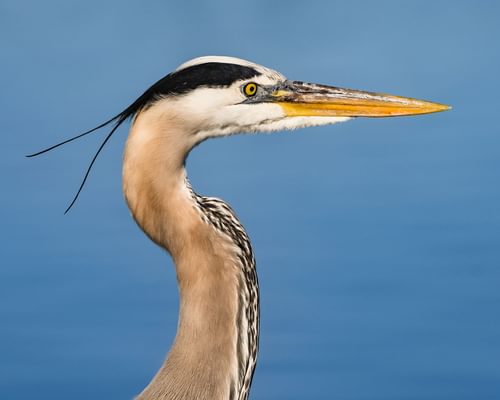Great blue herons (Ardea herodias) are widespread throughout North America. These magnificent wading birds are present in British Columbia, Central and Coastal Canada, the United States, Mexico, and even regions of Central America.
The great blue heron is only partially migratory. What regions the bird calls home determines when and if it flies south for the winter. Populations in Florida, the Pacific Northwest, and the Galapagos are generally non-migratory. On the other hand, blue herons residing in the rest of Canada and the northern United States migrate away from their higher latitude breeding grounds to warmer climates during winter.
Some of these migrate great distances, overwintering as far south as Guatemala in Central America or the Caribbean. We will dive into more details about the migratory habits of the blue heron throughout this article. Read on to discover more!

Great Blue Herons are partially migratory
When do blue herons migrate south?
Generally, great blue herons migrate south from their northern breeding ranges in mid-September to late October. Movements occur later in Alberta and Ontario with the majority of birds not leaving until November or December. Occasionally, early migrants are recorded in their southern territories as early as August.
When do blue herons migrate north?
Blue herons arrive back in their northern breeding grounds between February and April. Spring's arrival does not necessarily match up with the waning of winter weather. For example, herons returning to the midwest generally arrive in early February, while those returning to Kentucky may not reach their breeding grounds until late March.
Great blue herons that nest in central and coastal Canada usually do not return until mid-May. Some populations of great blue herons even travel as far north as Arctic Alaska and the northernmost Canadian Provinces, Yukon, Manitoba, Ontario, and Quebec.

A great blue heron perched on a branch
Why do blue herons migrate?
Great blue herons migrate based on food availability and, to an extent, weather conditions. Though these birds are well-adapted to a multitude of regions and can withstand relatively cold temperatures, the heron’s food sources become more scarce in winter. Food scarcity forces the heron to move south.
As a general rule, herons migrate from regions where water sources freeze during the cold season. A great blue heron’s diet consists of a variety of fish, amphibians, insects, mammals, birds, and crustaceans. Many of these animals are inaccessible beneath sheets of ice throughout long northern winters or are in hibernation.
How far do blue herons migrate?
Great blue heron populations that are migratory have quite a bit of variation in how far they travel. Some may only travel a few hundred miles away from the northern edges of their breeding grounds to warmer regions of the United States. However, other blue heron populations migrate more than 3,000 miles between northern ranges in Canada to wintering grounds in southern Mexico or northern South America.

A great blue heron preening its feathers
Do blue herons stay year-round?
The great blue heron is a partially migratory species. Some populations remain in or around their breeding grounds year-round. Herons that live in the Pacific Northwest, Florida, and the Galapagos are permanent residents. They can be seen throughout the year in their wetland and upland habitats, usually near bodies of water.
Do blue herons migrate in groups?
Generally, great blue herons migrate alone or in small groups of three to twelve individuals. Occasionally, groups numbering around 100 herons are recorded during migrations. These birds will travel by day and by night.

A small flock of blue herons, Whitty's Lagoon, southern Vancouver Island, British Columbia
Where do blue herons go in the winter?
Northern populations of the great blue heron move south to warmer climates for winter. These migratory populations are found in the southern United States, Mexico, northern South America, and the Caribbean.
Can blue herons survive winter?
Blue herons are extremely adaptable birds. They can survive winters in coastal Alaska, Canada, and the Northeastern United States. These regions offer plentiful year-round food sources because temperatures are more regulated and waters do not regularly freeze.
On the other hand, the heron would likely not survive long, harsh winters in central Canada and the northern Great Plains. For this reason, the great blue heron migrates south from these regions.

Blue heron in flight
Blue Heron Migration FAQs
Do blue herons migrate south for the winter?
Great blue herons are partial migrants. Populations in Florida, the Pacific Northwest, and the Galapagos do not migrate. Blue herons breeding in other regions of North America will move south for winter.
When do blue herons migrate north?
Blue herons generally migrate back north between mid-March and early May.
Do blue herons migrate from Michigan?
Most great blue herons in Michigan are migratory. Winters here are long and water sources tend to freeze the entire season. They leave this region in the late fall, around October, and return by mid-March.
Do blue herons migrate from Canada?
Most great blue herons migrate from Canada in the winter. Exceptions include west coast and east coast populations.
Do blue herons migrate from New England?
Most great blue herons migrate south from New England states in the winter. They generally leave the region between late July and September. However, populations in coastal New England tend to stay year-round. Waterways do not usually freeze over, so food availability is not an issue.

